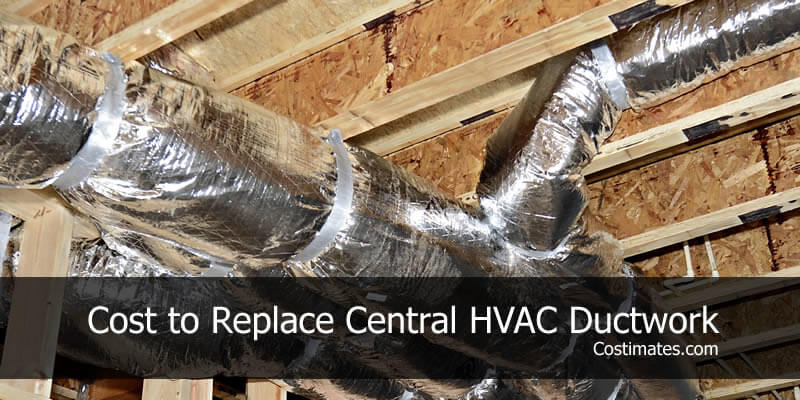The average cost to replace hvac ductwork is around $285 per duct run, and is based on the number of hvac duct runs to be replaced, length of each run, type and size of the replacement ductwork. When solid ducts in walls and ceilings must be replaced, the cost can rise to $550 per run or higher.
The most typical duct replacement cost range of $175 – $400 per duct includes removal of old duct and supply register, installation of the new flexible or metal duct, labor costs and disposal of all old materials.
Average Costs
Reasons to Replace Your HVAC Duct
There are two major reasons to replace ductwork.
- The old ductwork might be in such poor condition that repairing it isn’t advised. Old ducts leak as much as 35% of the treated air, leading to waste and higher-than-necessary energy costs. Some also rust due to condensation forming in them over many years.
- The old HVAC system was too large for the home. There was a time when contractors thought bigger was better, but that’s no longer true. A system that is too big wastes energy, creates temperature fluctuations and won’t adequately dehumidify a home in summer.
Even if the old system was the right size, upgrades such house wrap, energy efficient windows and increased insulation in the attic reduce the need for heating and air conditioning capacity, so the next HVAC system will be smaller. That may create the demand for smaller ductwork too.
Beware of price gouging! “Across the country, the gross profit for duct renovation work is reported at margins of 65% to 80%. That’s pretty sweet compared to the industry averages of 30% to 40% gross profit for equipment replacement,” according to Rob Falke, President of the National Comfort Institute, a company that helps HVAC companies improve business.
Knowing that huge margins, it makes sense to get estimates from at least 3 companies in your area with a reputation for fair dealing with customers and quality workmanship.
The rest of this Costimate covers cost factors, itemized pricing and duct work installation price estimates from other estimating sites. There’s a recommendation on DIY duct installation plus prices from homeowners that have recently had their ductwork replaced.
Replacement Cost Factors
Here are the factors that will determine where on that range your project will fall.
- Type of Ductwork System – The least expensive duct system is a radial system of flexible ducts in an attic running to ceiling grates. Ductwork running along an open ceiling in the basement of a one-story home is also more affordable to replace. The costliest are sheet metal ducts running in enclosed walls and ceilings. Most projects require more than one type of ductwork.
- Size of Your Home – Bigger homes require more linear feet of ductwork resulting in a higher cost.
- Access to Duct Runs – The accessibility of the duct run in your ceilings, floors, walls and such is a big factor on the cost. Duct in the attic is usually one of the easiest, followed closely by crawlspace duct systems. In multi-level homes, there may be duck sandwiched between the ceiling of the first floor and the floor of the second. These are going to be costly to replace.
- Whether Return Ducts are Used – Most homes have return ducts. A few homes with open floor plans and a first-floor HVAC system don’t require them, as air is easily drawn back to the furnace or air handler.
- Number of Duct Runs – House size is a factor here, but so is the layout of your home. A sprawling ranch might have more duct runs than a two-story of the same number of square feet.
- R-value of Insulated Ducts – Flexible ductwork running in open space like an attic will be insulated from about R6 to R10. The higher the R-value, the pricier the ducting. However, this is a cost that pays for itself quickly, so choose higher R-values when given an option. Note: Increasing the insulation throughout your home is always a great way to save on energy costs in all seasons. Review costs for spray foam insulation, as well as traditional blown in insulation costs to get an idea of cost versus savings.
- Wall/Ceiling Disruption – As noted, when drywall or drop-ceiling systems must be removed and replaced, the cost estimate will be close to the upper end of the spectrum. This is more common in multi-level homes.
- Mold Remediation – If the crew gets into wall space and finds significant levels of mold, it should be treated. While not common, mold remediation can be expensive. If it is extensive, you’ll incur costs beyond the range given above. That’s really a separate project.
- Zoning Equipment Inside Ducts – When dampers have to be removed and replaced, cost rises because of the additional materials and labor involved.
- Complexity of the Ducting – Some of the other factors enter into this – house size and layout, where the ductwork is located, age of the house and ducts, etc.
- Time of Year – How busy or slow the HVAC contractors are at the time you get estimates will probably affect their bids.
- Where you Live – Cost of living can affect costs by 10% to 25%. It is highest on the Coasts, especially in the NE and NW. The national average is found in large metro areas elsewhere, like Chicagoland and metropolitan Dallas/Ft. Worth. Cost of living is lowest in rural areas of the Midwest, Plains and the South.
Cost of Duct and Installation Supplies
Here are the itemized costs for the most common types of ductwork and supplies needed to complete installation.
- $1.10 – $5.25 per foot | Insulated flexible duct, 4” to 16” diameters used as branches or in radial duct attic systems
- $2.30 – $13.00 per foot | Round and oval sheet metal duct, 3” to 8” diameters typically used for trunks in small homes and branches in larger homes
- $6.50 – $12.00 per foot | Rectangular duct 6”x12” up to 12”x24” used as trunks
- $3.00 – $12.50 per foot | Spiral, decorative duct used where visible such as along the ceiling of a loft apartment
- $5.25 – $7.00 per foot | Duct stacks used in walls
- $50 – $150 each | Plenum used to connect the furnace or air handler to supply ducts and Cold Air Drop for connecting the return ducts to the furnace/air handler
- $225 – $575 | Fittings and accessories like boots, take-offs, joist pans and dampers
- $50 – $125 | Duct sealant including tape, insulating wrap and mastic
- $60 – $200 | Required tools depending on their quality
Permits, Inspection, and Installation Costs
It’s not common for a permit being required for duct replacement. Always check with your local codes though.
Installation Labor Factors
DIY ductwork saves on labor. See our recommendation below for whether ductwork installation is a DIY job.
- $4.50 – $8.25 per foot | Installation labor cost depending on type, complexity, location and how easy/hard it is to access.
Installation Time
Installing ductwork is a 1-4 day job because of the wide range of scenarios. Connecting an attic air handler to ceiling ducts in a single-story home is a quick project.
Installing ducts in a multistory home goes more slowly since wall stacks are included.
Here’s a typical scenario for a 2,000 – 2,500 square foot two-story.
- .5-1 Day | Expose and remove old ductwork
- 1-2 days | Install new ducts
- .5-1 day | Seal new ducts and complete the project
- Total = 2-4 days.
Related Projects
Are You an HVAC Pro?
If so, head over to our Costimates Pro’s page, and help us make this page better and more accurate for both our visitors and your future customers.
DIY or Hire a Pro
Is duct installation a DIY project? There are two major hurdles to success when a homeowner installs the ductwork.
First, you have to know the right combination of duct sizes to use throughout the system based on factors like the the volume of air your blower moves and the length of the duct runs. Figuring sizing is a complicated task.
There won’t be enough air pressure to move the air to the furthest reaches of the home if ducts are too large. Rooms nearest the furnace or air handler will get too much heated or air conditioned air.
If the ducts are too small, you will hear them whistle due to pressure that is too high, forcing air to escape through seams in the ductwork. The excessive pressure will eventually damage the ducts and lead to major leaks. It can also cause the blower to work too hard and fail prematurely.
An option that will save you most of the labor cost is to have an HVAC pro assist you with sizing the ductwork, then installing it yourself. That is, if you can find one willing to assist. Expect to pay $50-plus per hour for their time.
The second issue is that you have to be diligent about making every connection airtight with screws, tape and mastic. Otherwise, air will leak, and you’ll be losing the money you saved by installing it yourself.
Find information on how to correctly seal ducts, and then be meticulous about the process.
Given the importance of properly sizing and installing the ducting, our recommendation is to have a professional install ductwork.


 Steve Hansen, that's me, the Senior Editor of Costimates. (
Steve Hansen, that's me, the Senior Editor of Costimates. (